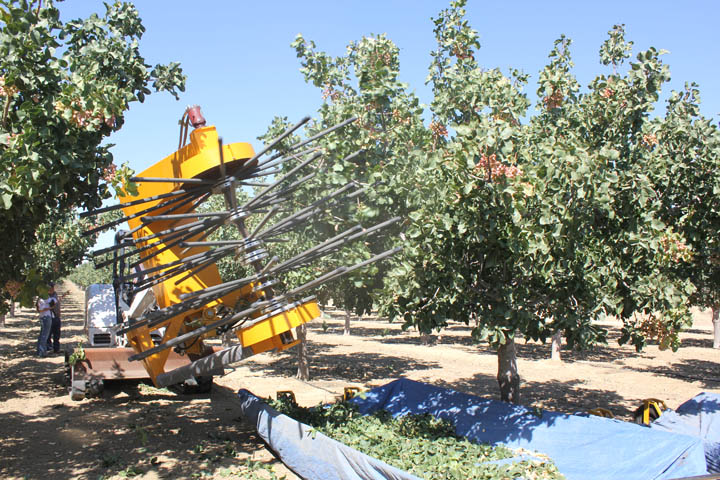October 14, 2011

Pistachio trees age much like humans — they get taller and their girth expands as the years pass.
Maturity changes in pistachio trees may necessitate alternative harvest techniques to maintain efficiency as the trees grow older. Traditional trunk shakers remove a smaller percentage of marketable nuts as trunks grow in diameter and canopies spread out. Older trees of some pistachio varieties also sustain trunk damage as they grow older.
The California pistachio industry is still relatively young and University of California Cooperative Extension pomologist Louise Ferguson says growers should be prepared for challenges that come with aging trees.
Ferguson and harvesting equipment manufacturers are studying harvest alternatives, including different shaking patterns of trunk shakers and a using a direct canopy contact harvesting head design originally developed for mechanically harvesting olives.
Ferguson, who has done extensive research in mechanically harvesting olives, said a limited pistachio harvest trial conducted in 2009 showed traditional shaking left an average of 38 percent of the in-shell split nuts per tree.
Another evaluation in 2010 did find higher efficiency rates with the trunk shakers. Four commercial harvesters and two experimental machines were used in the trial. The commercial machines averaged 83 percent efficiency while the experimental shakers from Erik Nielsen Enterprises averaged 96 percent. These were all in trees with trunk circumference of less than 50 inches. Above 50 inches, the efficiency of all shakers tested decreased.
When harvest efficiency falls off in older orchards, growers can replant the orchard. However, Ferguson the costs and time it takes to regain production could make re-evaluating trunk shaker patterns and looking at alternatives economically feasible.
After trials in some of Paramount Farming’s Kern County pistachio orchards, Ferguson was optimistic the direct contact harvesting head could remove a high percentage of marketable nuts.
“It will work, but it will take some modification — both with the mechanics and the trees,” said Ferguson. “Where there is contact, we’re getting good removal. Where there is not, nuts remain on the tree.”
Harvest efficiency
Mechanical pruning to control canopy height improved harvest efficiency since shakers are more efficient removing nuts closes to the trunk, said Ferguson. This practice has a bonus of helping control alternate bearing in pistachios, added Ferguson. Ferguson says it became obvious that managing the trees for different harvesting systems would become critical in changing harvesting techniques. Growers looking ahead to use the direct canopy harvester may look at closer tree spacing in more of a hedgerow to facilitate the alternative picking head as trees mature, she said.
Ferguson, UC Davis engineers John Miles and Jed Roach and harvest crews from Paramount Farms this fall evaluated the direct contact harvesting head in 10-year old trees were in full production in a moderate “on” year for pistachios.
Ferguson said Chevron also has contributed to the technology by sponsoring development of a vibrating harvesting head to harvest the biodiesel crop jatropha. Ferguson said their engineer allowed her to adapt the technology for pistachios. The head for this trial, mounted on a Bobcat, was developed by UC engineer Uriel Rosa.
The vibrating rubber-clad fiberglass rods rake through the branches as the head moves across each tree. There are 12 rods in each row. The head move along the sides of the trees and penetrate the canopy toward the tree centers. In the trial this fall the machine was harvesting 36 trees every 20 minutes. Miles said the harvester is capable of moving faster.
While promising, Miles acknowledged more design work is necessary because some rods broke when they hit larger branches. Ferguson was also closely checking the small branches that were removed evaluate the number of fruit buds — next year’s pistachio crop — that were lost.
Although all the data has not been analyzed, Ferguson said, it looks as if the experimental head is consistent with the higher efficiency found during the 2010 trial. Gavin Nielsen of Erick Nielsen Enterprises said the company has been collaborating with Gold Country Hydraulics on new mechanical harvest technology.
“Our focus is to find inexpensive solutions to this challenging problem,” said Nielsen.
Both Paramount and the California Pistachio Research Board (CPRB) have supported this research, Ferguson said.
Bob Klein, manager of CPRB, said this marks the second year the board has funded research for this vital component of the industry.
You May Also Like




